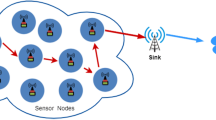Abstract
Advanced transportation sensors use a wireless medium to communicate and use data fusion techniques to provide complete information. Large-scale use of intelligent transportation sensors can lead to data bottlenecks in an ad-hoc wireless sensor network, which needs to be reliable and should provide a framework to sensors that constantly join and leave the network. A possible solution is to use public transportation vehicles as data fusion nodes or cluster heads. This paper presents a mathematical programming approach to use public transportation vehicles as cluster heads. The mathematical programming solution seeks to maximize benefit achieved by covering both mobile and stationary sensors, while considering cost/penalty associated with changing cluster head locations. A simulation is developed to capture realistic considerations of a transportation network. This simulation is used to validate the solution provided by the mathematical model.


Similar content being viewed by others
References
Afsar M, Tayarani M (2014) Clustering in sensor networks: a literature survey. J Netw Comput Appl 46:196–226
Basu P, Khan N, Little T (2001) A mobility based metric for clustering in mobile ad hoc networks. In: 2001 international conference on distributed computing systems workshop, pp 413–418
Boyinbode O, Le H, Mbogho A, Takizawa M, Poliah, R (2010) A survey on clustering algorithms for wireless sensor networks. In: 2010 13th international conference on network-based information systems (NBiS), pp 358–364
Chan H, Perrig A (2004) Ace: an emergent algorithm for highly uniform cluster formation. In: Karl H, Wolisz A, Willig A (eds) Lecture notes in computer science, vol 2920. Springer, Berlin, Heidelberg, pp 154–171
Erdemir ET, Batta R, Rogerson P, Speilman S, Blatt A, Flanigan M (2008) Location coverage models with demand originating from nodes and paths: application to cellular network design. Eur J Oper Res 190(3):610–633
Furuta T, Sasaki M, Ishizaki F, Suzuki A, Miyazawa H (2009) A new clustering model of wireless sensor networks using facility location theory. J Oper Res Soc Jpn 52(4):366–376
Geetla T, Batta R, Blatt A, Flanigan M, Majka K (2014) Optimal placement of omnidirectional sensors in a transportation network for effective emergency response and crash characterization. Transport Res Part C: Emerg Technol 45:64–82
Greater Buffalo-Niagara Regional Transportational Council (2010) Geographic information system. http://www.gbnrtc.org/index.php/planning/gis/. Accessed 3 June 2013
Hall D, Llinas J (1997) Introduction to multi-sensor data fusion. Proc IEEE 85:6–23
Heinzelman WB, Chandrakasan AP, Balakrishnan H (2002) An application-specific protocol architecture for wireless microsensor networks. IEEE Trans Wirel Commun 1(4):660–670
Henchey M, Batta R, Blatt A, Flanigan M, Majka K (2013) A simulation approach to studying emergency response in an advanced transportation system. J Simul 8:115–128
IBM ILOG CPLEX Support (2005) Cplex performance tuning for mixed integer programs. http://www-01.ibm.com/support/docview.wssuidswg21400023. Accessed 3 June 2013
Labroche N, Monmarche N, Venturini G (2002) A new clustering algorithm based on the chemical recognition system of ants. In: Proceedings of ECAI, pp 345–349
Mainwaring A, Culler D, Polastre J, Szewczyk R, Anderson J (2002) Wireless sensor networks for habitat monitoring. In: Proceedings of the 1st ACM international workshop on wireless sensor networks and applications, pp 88–97
Mehr M (2014) Cluster head election using imperialist competitive algorithm (chei) for wireless sensor networks. Int J Mobile Netw Commun Telemat 4(3):1–9
Patel D, Batta R, Nagi R (2005) Clustering sensors in wireless ad hoc networks operating in a threat environment. Oper Res 53(3):432–442
Sorokin A, Boyko N, Boginski V, Uryasev S, Pardalos PM (2009) Mathematical programming techniques for sensor networks. Algorithms 1:565–581
Younis O, Fahmy S (2004) Heed: a hybrid, energy-efficient distributed clustering approach for ad hoc sensor networks. IEEE Trans Mobile Comput 3(4):366–379
Acknowledgments
The authors would like to thank the two anonymous who provided us with excellent advice and guidance to strengthen and improve our paper. This material is based on work supported by the FHWA under Cooperative Agreement No. DTFH61-07-H-00023, awarded to the Center for Transportation Injury Research, CUBRC, Inc., Buffalo, NY. Any opinions, findings and conclusions are those of the author(s) and do not necessarily reflect the view of the FHWA.
Author information
Authors and Affiliations
Corresponding author
Rights and permissions
About this article
Cite this article
Geetla, T., Batta, R., Blatt, A. et al. Clustering intelligent transportation sensors using public transportation. TOP 24, 594–611 (2016). https://doi.org/10.1007/s11750-016-0410-7
Received:
Accepted:
Published:
Issue Date:
DOI: https://doi.org/10.1007/s11750-016-0410-7




